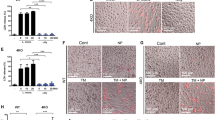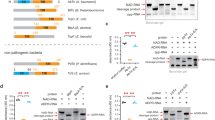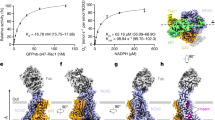Abstract
Reactive oxygen species (ROS) produced by NADPH oxidase function as defence and signalling molecules related to innate immunity and various cellular responses1,2. The activation of NADPH oxidase in response to plasma membrane receptor activation depends on the phosphorylation of cytoplasmic oxidase subunits, their translocation to membranes and the assembly of all NADPH oxidase components3. Tumour necrosis factor (TNF) is a prominent stimulus of ROS production, but the molecular mechanisms by which TNF activates NADPH oxidase are poorly understood. Here we identify riboflavin kinase (RFK, formerly known as flavokinase4) as a previously unrecognized TNF-receptor-1 (TNFR1)-binding protein that physically and functionally couples TNFR1 to NADPH oxidase. In mouse and human cells, RFK binds to both the TNFR1-death domain and to p22 phox , the common subunit of NADPH oxidase isoforms. RFK-mediated bridging of TNFR1 and p22 phox is a prerequisite for TNF-induced but not for Toll-like-receptor-induced ROS production. Exogenous flavin mononucleotide or FAD was able to substitute fully for TNF stimulation of NADPH oxidase in RFK-deficient cells. RFK is rate-limiting in the synthesis of FAD, an essential prosthetic group of NADPH oxidase. The results suggest that TNF, through the activation of RFK, enhances the incorporation of FAD in NADPH oxidase enzymes, a critical step for the assembly and activation of NADPH oxidase.
This is a preview of subscription content, access via your institution
Access options
Subscribe to this journal
Receive 51 print issues and online access
$199.00 per year
only $3.90 per issue
Buy this article
- Purchase on Springer Link
- Instant access to full article PDF
Prices may be subject to local taxes which are calculated during checkout




Similar content being viewed by others
References
Lambeth, J. D. NOX enzymes and the biology of reactive oxygen. Nature Rev. Immunol. 4, 181–189 (2004)
Bedard, K. & Krause, K. H. The NOX family of ROS-generating NADPH oxidases: physiology and pathophysiology. Physiol. Rev. 87, 245–313 (2007)
Vignais, P. V. The superoxide-generating NADPH oxidase: structural aspects and activation mechanism. Cell. Mol. Life Sci. 59, 1428–1459 (2002)
Merrill, A. H. & McCormick, D. B. Preparation of flavin 5′-phosphates using immobilized flavokinase. Methods Enzymol. 66, 287–290 (1980)
Kim, Y. S., Morgan, M. J., Choksi, S. & Liu, Z. G. TNF-induced activation of the Nox1 NADPH oxidase and its role in the induction of necrotic cell death. Mol. Cell 26, 675–687 (2007)
Hsu, H., Xiong, J. & Goeddel, D. V. The TNF receptor 1-associated protein TRADD signals cell death and NF-κB activation. Cell 81, 495–504 (1995)
Zhang, S. Q., Kovalenko, A., Cantarella, G. & Wallach, D. Recruitment of the IKK signalosome to the p55 TNF receptor: RIP and A20 bind to NEMO (IKKγ) upon receptor stimulation. Immunity 12, 301–311 (2000)
Micheau, O. & Tschopp, J. Induction of TNF receptor I-mediated apoptosis via two sequential signaling complexes. Cell 114, 181–190 (2003)
Adam-Klages, S. et al. FAN, a novel WD-repeat protein, couples the p55 TNF-receptor to neutral sphingomyelinase. Cell 86, 937–947 (1996)
Tsao, D. H., Hum, W. T., Hsu, S., Malakian, K. & Lin, L. L. The NMR structure of the TRADD death domain, a key protein in the TNF signaling pathway. J. Biomol. NMR 39, 337–342 (2007)
Karthikeyan, S. et al. Crystal structure of human riboflavin kinase reveals a β barrel fold and a novel active site arch. Structure 11, 265–273 (2003)
Schneider-Brachert, W. et al. Compartmentalization of TNF receptor 1 signaling: internalized TNF receptosomes as death signaling vesicles. Immunity 21, 415–428 (2004)
Ermolaeva, M. A. et al. Function of TRADD in tumor necrosis factor receptor 1 signaling and in TRIF-dependent inflammatory responses. Nature Immunol. 9, 1037–1046 (2008)
Rodriguez, C. I. et al. High-efficiency deleter mice show that FLPe is an alternative to Cre-loxP. Nature Genet. 25, 139–140 (2000)
Stuehr, D. J. Mammalian nitric oxide synthases. Biochim. Biophys. Acta 1411, 217–230 (1999)
Ross, N. S. & Hansen, T. P. Riboflavin deficiency is associated with selective preservation of critical flavoenzyme-dependent metabolic pathways. Biofactors 3, 185–190 (1992)
Peitz, M., Pfannkuche, K., Rajewsky, K. & Edenhofer, F. Ability of the hydrophobic FGF and basic TAT peptides to promote cellular uptake of recombinant Cre recombinase: a tool for efficient genetic engineering of mammalian genomes. Proc. Natl Acad. Sci. USA 99, 4489–4494 (2002)
Kuhn, R., Schwenk, F., Aguet, M. & Rajewsky, K. Inducible gene targeting in mice. Science 269, 1427–1429 (1995)
Ho, A., Schwarze, S. R., Mermelstein, S. J., Waksman, G. & Dowdy, S. F. Synthetic protein transduction domains: enhanced transduction potential in vitro and in vivo . Cancer Res. 61, 474–477 (2001)
Hordijk, P. L. Regulation of NADPH oxidases: the role of Rac proteins. Circ. Res. 98, 453–462 (2006)
Hashida, S. et al. Binding of FAD to cytochrome b 558 is facilitated during activation of the phagocyte NADPH oxidase, leading to superoxide production. J. Biol. Chem. 279, 26378–26386 (2004)
Tsunawaki, S. & Nathan, C. F. Enzymatic basis of macrophage activation. Kinetic analysis of superoxide production in lysates of resident and activated mouse peritoneal macrophages and granulocytes. J. Biol. Chem. 259, 4305–4312 (1984)
El-Benna, J., Dang, P. M. & Gougerot-Pocidalo, M. A. Priming of the neutrophil NADPH oxidase activation: role of p47phox phosphorylation and NOX2 mobilization to the plasma membrane. Semin. Immunopathol. 30, 279–289 (2008)
Sheppard, F. R. et al. Structural organization of the neutrophil NADPH oxidase: phosphorylation and translocation during priming and activation. J. Leukoc. Biol. 78, 1025–1042 (2005)
Lin, Y. et al. Tumor necrosis factor-induced nonapoptotic cell death requires receptor-interacting protein-mediated cellular reactive oxygen species accumulation. J. Biol. Chem. 279, 10822–10828 (2004)
Fiers, W., Beyaert, R., Declercq, W. & Vandenabeele, P. More than one way to die: apoptosis, necrosis and reactive oxygen damage. Oncogene 18, 7719–7730 (1999)
Kamata, H. et al. Reactive oxygen species promote TNFα-induced death and sustained JNK activation by inhibiting MAP kinase phosphatases. Cell 120, 649–661 (2005)
White, D. J., Merod, R., Thomasson, B. & Hartzell, P. L. GidA is an FAD-binding protein involved in development of Myxococcus xanthus . Mol. Microbiol. 42, 503–517 (2001)
Kruisbeek, A. M. & Vogel, S. N. in Current Protocols in Immunology Vol. 3 (ed. Coligan, J. E. et al.) p. 14.5.1 (John Wiley, 1999)
Wiegmann, K. et al. Requirement of FADD for tumor necrosis factor-induced activation of acid sphingomyelinase. J. Biol. Chem. 274, 5267–5270 (1999)
Acknowledgements
We thank M. Pasparakis for TRADD-deficient and TNFR1-deficient MEFs, R. Brandes for gp91-deficient mice and helpful discussions, and D. Männel for TNFR1 and TNFR2 doubly deficient MEFs and for recombinant TNF. This work was supported by grants from the Deutsche Forschungsgemeinschaft (DFG; SFB670 to O.K., J.C.B., O.U. and M.K., and SFB415 to S.S.), DFG grant 733/7-1 to S.S., and a grant from the DFG Leibniz programme to J.C.B. and M.K.
Author Contributions Experiments were performed by B.Y. (Figs 2 and 4, and Supplementary Figs 2b, 3a, b, 5, 6a, b and 8–11). K.W. originally cloned the RFK cDNA (Figs 1c, 2f–h and 3c, d, and Supplementary Figs 2b, 4, 7 and 9). V.T. and S.S. analysed TNF receptosomes (Figs 1a–e and 3a, b, and Supplementary Fig. 3c). O.K. planned experimental approaches (Supplementary Fig. 1). C.P. (Fig. 2c), M.S. and O.U. (Supplementary Figs 6c and 7) performed ROS and NO measurements in RFK-deficient cells. H.K. supervised the apoptosis assays. A.K., T.W. and J.C.B. contributed to the knockout strategy for the generation of RFK-deficient strain of mice. M.K. conceived the study, evaluated the experimental results and wrote the paper.
Author information
Authors and Affiliations
Corresponding author
Supplementary information
Supplementary Figures
This file contains Supplementary Figures 1-11 with Legends. (PDF 2801 kb)
Rights and permissions
About this article
Cite this article
Yazdanpanah, B., Wiegmann, K., Tchikov, V. et al. Riboflavin kinase couples TNF receptor 1 to NADPH oxidase. Nature 460, 1159–1163 (2009). https://doi.org/10.1038/nature08206
Received:
Accepted:
Published:
Issue Date:
DOI: https://doi.org/10.1038/nature08206
This article is cited by
-
New insights into the nutritional genomics of adult-onset riboflavin-responsive diseases
Nutrition & Metabolism (2023)
-
Roles of RIPK3 in necroptosis, cell signaling, and disease
Experimental & Molecular Medicine (2022)
-
Melatonin Administration Prevents Placental and Fetal Changes Induced by Gestational Diabetes
Reproductive Sciences (2022)
-
Antioxidant and food additive BHA prevents TNF cytotoxicity by acting as a direct RIPK1 inhibitor
Cell Death & Disease (2021)
-
Mechanisms and pathogenesis underlying environmental chemical-induced necroptosis
Environmental Science and Pollution Research (2020)
Comments
By submitting a comment you agree to abide by our Terms and Community Guidelines. If you find something abusive or that does not comply with our terms or guidelines please flag it as inappropriate.



